
- •Input/Output (I/O) capabilities
- •Discrete I/O
- •Analog I/O
- •Network I/O
- •Logic programming
- •Relating I/O status to virtual elements
- •Memory maps and I/O addressing
- •Ladder Diagram (LD) programming
- •Contacts and coils
- •Counters
- •Timers
- •Data comparison instructions
- •Math instructions
- •Sequencers
- •Structured Text (ST) programming
- •Instruction List (IL) programming
- •Function Block Diagram (FBD) programming
- •Sequential Function Chart (SFC) programming
- •Human-Machine Interfaces
- •How to teach yourself PLC programming
- •Review of fundamental principles
- •Analog electronic instrumentation
- •4 to 20 mA analog current signals
- •Relating 4 to 20 mA signals to instrument variables
- •Example calculation: controller output to valve
- •Example calculation: temperature transmitter
- •Example calculation: pH transmitter
- •Example calculation: PLC analog input scaling
- •Graphical interpretation of signal ranges
- •Thinking in terms of per unit quantities
- •Controller output current loops
- •Troubleshooting current loops
- •Using a standard milliammeter to measure loop current
- •Using shunt resistors to measure loop current
- •Troubleshooting current loops with voltage measurements
- •Using loop calibrators
- •NAMUR signal levels
- •Review of fundamental principles
- •Pneumatic instrumentation
- •Pneumatic sensing elements
- •Self-balancing pneumatic instrument principles
- •Pilot valves and pneumatic amplifying relays
- •Analogy to opamp circuits
- •Analysis of practical pneumatic instruments
- •Proper care and feeding of pneumatic instruments
- •Advantages and disadvantages of pneumatic instruments
- •Review of fundamental principles
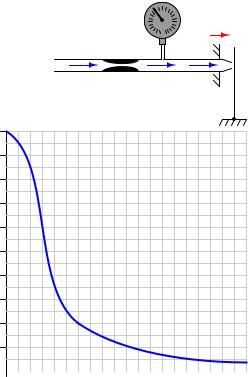
14.1. PNEUMATIC SENSING ELEMENTS |
923 |
14.1Pneumatic sensing elements
Most pneumatic instruments use a simple but highly sensitive mechanism for converting mechanical motion into variable air pressure: the ba e-and-nozzle assembly (sometimes referred to as a flapper- and-nozzle assembly). A ba e is nothing more than a flat object obstructing the flow of air out of a small nozzle by close proximity:
Pressure gauge
P |
x |
|
From compressed air supply 
(20 PSI)

 Clearance
Clearance
Orifice |
Nozzle |
Baffle
Pivot
20
18
16
14
12 Backpressure at 10
nozzle (PSI)
P8
6
4
2
0  0 1 2 3 4 5 6 7 8 9 10
0 1 2 3 4 5 6 7 8 9 10
Clearance, mils (thousandths of an inch) x
The physical distance between the ba e and the nozzle alters the resistance of air flow through the nozzle. This in turn a ects the air pressure built up inside the nozzle (called the nozzle backpressure). Like a voltage divider circuit formed by one fixed resistor and one variable resistor, the ba e/nozzle mechanism “divides” the pneumatic source pressure to a lower value based on the ratio of restrictiveness between the nozzle and the fixed orifice.
This crude assemblage is surprisingly sensitive, as shown by the graph. With a small enough orifice, just a few thousandths of an inch of motion is enough to drive the pneumatic output between its saturation limits. Pneumatic transmitters typically employ a small sheet-metal lever as the ba e. The slightest motion imparted to this ba e by changes in the process variable (pressure,

924 |
CHAPTER 14. PNEUMATIC INSTRUMENTATION |
temperature, flow, level, etc.) detected by some sensing element will cause the air pressure to change in response.
The principle behind the operation of a ba e/nozzle mechanism is often used directly in qualitycontrol work, checking for proper dimensioning of machined metal parts. Take for instance this shaft diameter checker, using air to determine whether or not a machined shaft inserted by a human operator is of the proper diameter after being manufactured on an assembly line:
From compressed |
Orifice |
|
air supply |
|
|
(20 PSI) |
|
|
|
Test jig |
Pressure gauge |
|
Clearance |
Machined metal shaft
If the shaft diameter is too small, there will be excessive clearance between the shaft and the inside diameter of the test jig, causing less air pressure to register on the gauge. Conversely, if the shaft diameter is too large, the clearance will be less and the gauge will register a greater air pressure because the flow of air will be obstructed by the reduced clearance. The exact pressure is of no particular consequence to the quality-control operator reading the gauge. What does matter is that the pressure falls within an acceptable range, reflecting proper manufacturing tolerances for the shaft. In fact, just like the 3-15 PSI “receiver gauges” used as pneumatic instrument indicators, the face of this pressure gauge might very well lack pressure units (such as kPa or PSI), but rather be labeled with a colored band showing acceptable limits of mechanical fit:
Good
(reject)
(reject)
This is another example of the analog nature of pneumatic pressure signals: the pressure registered by this gauge is analogous to a completely di erent variable, in this case the mechanical fit of the shaft to the test jig.
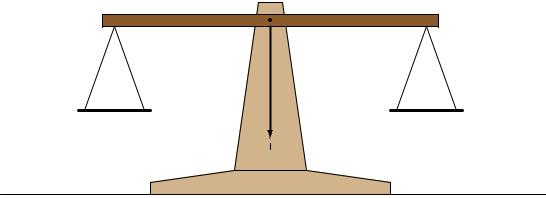
14.2. SELF-BALANCING PNEUMATIC INSTRUMENT PRINCIPLES |
925 |
Although it is possible to construct a pneumatic instrument consisting only of a ba e/nozzle mechanism, this is rarely done. Usually the ba e/nozzle mechanism is just one of several components comprising a “balancing” mechanism in a pneumatic instrument. It is this concept of self-balancing that we will study next.
14.2Self-balancing pneumatic instrument principles
A great many precision instruments use the principle of balance to measure some quantity. Perhaps the simplest example of a balance-based instrument is the common balance-beam scale used to measure mass in a laboratory:
A specimen of unknown mass is placed in one pan of the scale, and precise weights are placed in the other pan until the scale achieves a condition of balance. When balance is achieved, the mass of the specimen is known to be equal to the sum total of mass in the other pan. An interesting detail to note about the scale itself is that it has no need of routine calibration. There is nothing to “drift” out of spec which would cause the scale to read inaccurately. In fact, the scale itself doesn’t even have a gauge to register the mass of the specimen: all it has is a single mark indicating a condition of balance. To express this more precisely, the balance beam scale is actually a di erential mass comparison device, and it only needs to be accurate at a single point: zero. In other words, it only has to be correct when it tells you there is zero di erence in mass between the specimen and the standard masses piled on the other pan.
The elegance of this mechanism allows it to be quite accurate. The only real limitation to accuracy is the certainty to which we know the masses of the balancing weights.
Imagine being tasked with the challenge of automating this laboratory scale. Suppose we grew weary of employing a lab technician to place standard weights on the scale to balance it for every new measurement, and we decided to find a way for the scale to balance itself. Where would we start? First we would need some sort of mechanism to sense when the scale was out of balance, and another mechanism to apply more or less downward force on the other pan whenever an out- of-balance condition was detected.
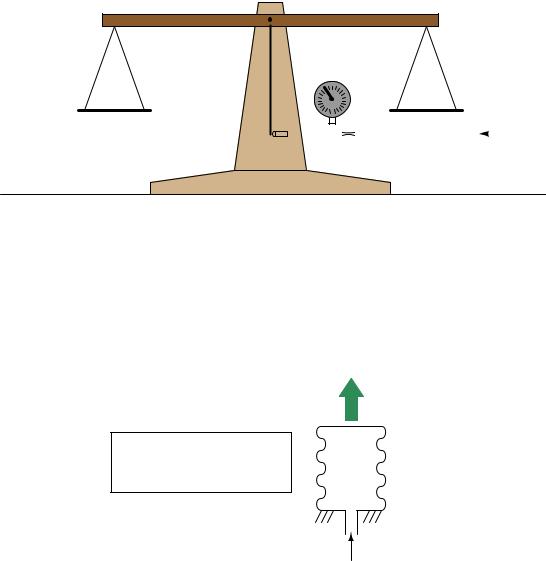
926 |
CHAPTER 14. PNEUMATIC INSTRUMENTATION |
The ba e/nozzle mechanism previously discussed would su ce quite well as a detection mechanism: simply attach a ba e to the end of the pointer on the scale, and attach a nozzle adjacent to the ba e at the “zero” position (where the pointer should come to a rest at balance). Such a mechanism might look like this:
Gauge
|
|
|
Tube |
Air supply |
||
|
|
|
||||
|
|
|
||||
|
|
|
|
|
|
|
Nozzle Orifice
Now we have a highly sensitive means of indicating when the scale is balanced, but we still have not yet achieved full automation. The scale cannot balance itself, at least not yet.
Suppose now instead of using precise, machined, brass weights placed on the other pan to counter the mass of the specimen, we employ a pneumatically-actuated force generator operated by the backpressure of the nozzle. An example of such a “force generator” is a bellows: a device made of thin sheet metal with circular corrugations in it, such that it resembles the bellows on an accordion. Pneumatic pressure applied to the interior of the bellows causes it to elongate, the amount of force applied to the bellows’ end being the product of air pressure and the end surface area:
|
Force |
Force = Pressure × Area |
Area |
|
|
F = PA |
Bellows |
|
Applied pressure
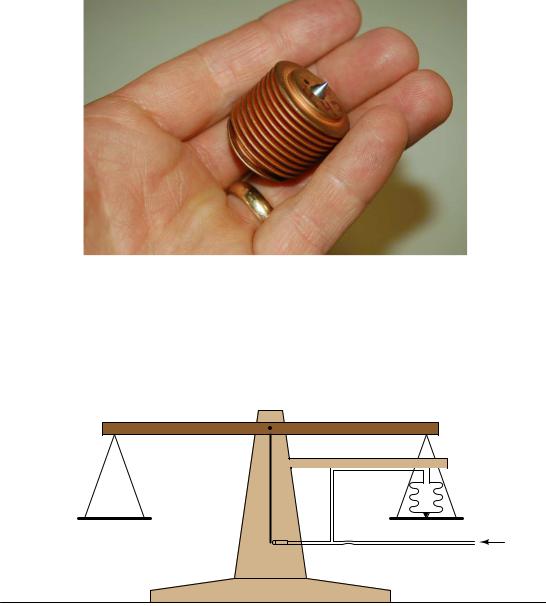
14.2. SELF-BALANCING PNEUMATIC INSTRUMENT PRINCIPLES |
927 |
A photograph of a brass bellows unit appears here, taken from a Foxboro model 130 pneumatic controller:
If the bellows’ expansion is externally restrained so it does not stretch appreciably – and therefore the metal never stretches enough to act as a restraining spring – the force exerted by the bellows on that restraining object will exactly equal the pneumatic pressure multiplied by the cross-sectional area of the bellows’ end.
Applying this to the problem of the self-balancing laboratory scale, imagine fixing a bellows to the frame of the scale so it presses downward on the pan where the brass weights normally go, then connecting the bellows to the nozzle backpressure:
|
Bellows |
|
|
Tube |
Air supply |
Nozzle |
Orifice |
|
Now the scale will self-balance. When mass is added to the left-hand pan, the pointer (ba e) will move ever so slightly toward the nozzle until enough backpressure builds up behind the nozzle to make the bellows exert an equal and opposing force to re-balance the mechanism. This balancing action is entirely automatic: the nozzle backpressure adjusts to whatever value is necessary to
928 |
CHAPTER 14. PNEUMATIC INSTRUMENTATION |
maintain the pointer in the balanced position, applying or venting pressure to the bellows as needed to keep the system in a condition of equilibrium. What we have created is a negative feedback system, where the output of the system (nozzle backpressure) continuously adjusts to match and balance the input (the applied weight).
This is all well and good, but how does this help us determine the weight of the specimen in the left-hand pan? What good is this self-balancing scale if we cannot read the balancing force? All we have achieved so far is to make the scale self-balancing. The next step is making the balancing force readable to a human operator.
Before we add the final piece to this automated scale, it is worthwhile to reflect on what has been done so far. By adding the ba e/nozzle and bellows mechanisms to the scale, we have abolished the need for brass weights and instead have substituted air pressure. In e ect, the scale translates applied weight into a proportional air pressure: air pressure has now become an analogue for specimen weight. What we really need is a way to now translate that air pressure into a human-readable indication of weight.
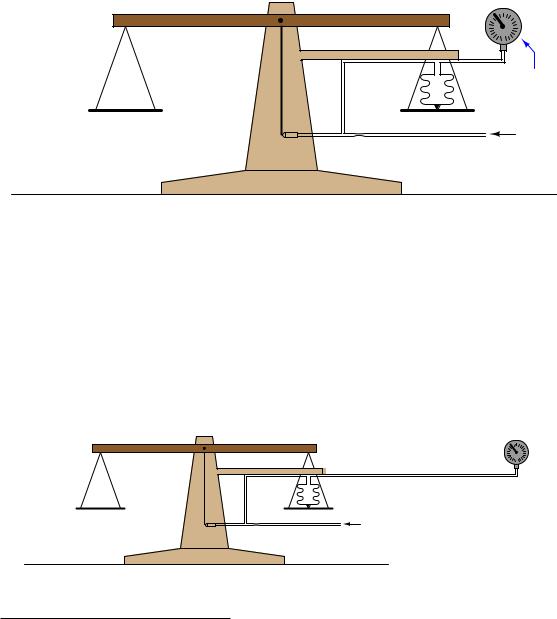
14.2. SELF-BALANCING PNEUMATIC INSTRUMENT PRINCIPLES |
929 |
To make this air pressure readable to a human operator, all we must add to the system is a pressure gauge. The gauge operates on air pressure, but now the air pressure is proportionately equivalent to specimen weight. In honor of this proportionality, we may label the face of the pressure gauge in units of ounces or grams instead of PSI or kPa:
Pressure gauge
|
Bellows |
|
Tube |
Nozzle |
Orifice |
Labeled in units of ounces or grams
Air supply
It is very important to note how the pressure gauge performs an entirely di erent function with the feedback bellows in place. With just a ba e-nozzle mechanism at work, the pressure gauge was hyper-sensitive to any motion of the scale’s balance beam – it served only as a highly sensitive indicator of balance. Now, with the addition of the feedback bellows, the pressure gauge actually indicates how much weight is in the specimen pan, not merely whether the scale is balanced or not. As we add more mass to the specimen pan, the gauge’s indication proportionately increases. As we take away mass from the specimen pan, the gauge’s indication proportionately decreases.
Although it may seem as though we are done with the task of fully automating the laboratory scale, we can go a step further. Building this pneumatic negative-feedback balancing system provides us with a capability the old manually-operated scale never had: remote indication. There is no reason why the indicating gauge must be located near the scale. Nothing prevents us from locating the receiver gauge some distance from the scale, and using long lengths of tubing to connect the two:
Pressure gauge
A long distance away
|
Bellows |
|
|
Tube |
Air supply |
Nozzle |
Orifice |
|
By equipping the scale with a pneumatic self-balancing apparatus, we have turned it into a pneumatic weight transmitter 3, capable of relaying the weight measurement in analog pneumatic
3In ISA parlance, this would be a “WT” instrument, “W” signifying weight and “T” signifying transmitter.
